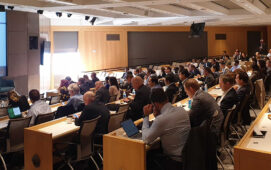
By Jeremy Katzeff, head of buy-side solutions at GoldenSource.
After much speculation, it’s now confirmed. The asset management industry welcomes another mega fund to its ranks after the tie-up between the asset management businesses of Natixis and Generali Group.
The reasons behind the merger are the same as they have been for the last few years, in which time the consolidation trend in the asset management space has gathered steam. Firms are facing increasing competition to achieve scale, manage changing investor preferences to lower-cost investment vehicles and tap into private markets. One only has to look at the latest news that Vanguard is slashing the fees on its fund products as an example of the competition taking shape in asset management today.
However, while a merger presents an opportunity for asset managers to try and fight back, any merger of this size will unearth a number of operational challenges. Looking a bit closer at this particular example, the operational complexities of the merger seem monumental.
Natixis Investment Managers runs a multi-boutique model, having acquired various specialist houses to capitalize on growing demand for alternative assets. Generali Investments, meanwhile, has a platform of 12 different investment management firms. Now the dust has settled on the deal, the board will be faced with a big question on how they can unite multiple funds, as well as the unique cultures of the two firms, in a clean and coherent fashion.
The ongoing evolution in how investment strategies are managed further complicates the picture. The internal composition of modern asset management firms is very different now than it was 10 or 20 years ago, when portfolio construction was built on listed equities, fixed income and some derivatives. The plethora of different asset types that buy-side participants now invest in, and the range of different financial instruments that they utilize, are reflected in far more complex operational requirements and larger middle and back-office departments.
The variety of different operating models that Natixis and Generali will be utilizing is undoubtedly reflected in the spiderweb of different internal systems and data sets that hold the entire operation together. This is especially true when private market assets are thrown into the mix as they are distinct from public market assets, particularly when it comes to how they must be treated from an operational and regulatory perspective. This is reflected in the data underpinning these assets, which is distinct in nature from the data for public markets.
Many of these subsidiary funds are likely still reliant on legacy technology, with layered improvements made over years of use. This can work for a time, but as businesses scale, it becomes more challenging. When major merger activity occurs, it becomes nearly impossible.
This merger could offer a stark lesson for asset managers around the importance of having a clean operational bill of health before engaging in M&A activity. For those that are not able to rely on modern, cloud-based data management architecture, the time and cost to achieve a fully harmonised and successful merger could be astronomical.
Also, in terms of the regulatory environment, a lot more pressure is being placed on asset managers to meet operational resilience requirements, with the European Union’s Digital Operational Resilience Act (DORA) and CPS 230 in Australia. Under these regulations, firms need to prove they have conducted vendor due diligence. They must also provide evidence that key service providers have robust risk management and resilience capabilities in place – safeguards that are essential in minimize any negative impacts when disruptive market events, like mergers and acquisitions, arise.
Only time will tell whether the tie-up between Generali and Natixis will be successful. But for those who think this trend will continue, it is time to reconsider their operational model, and the data systems and technology stack that underpin it.
Subscribe to our newsletter





